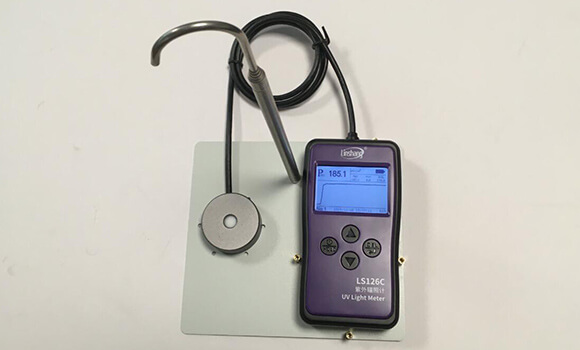UV Detector Test Germicidal Lamp
Ultraviolet rays are rays of sunlight with a wavelength of 10 to 400 nm. At the same time, they can be divided into UVA (wavelength 320 to 400 nanometers, long wave), UVB (wavelength 280 to 320 nanometers, medium wave) and UVC (wavelength 100 to 280 nanometers).
Pointed out in the "New Coronavirus Infection Pneumonia Diagnosis and Treatment Program (Trial Sixth Edition)" that the new coronavirus is sensitive to ultraviolet rays. The UVC emitted by the germicidal lamp is good at destroying the DNA structure of the bacteria genetic material and viruses, causing it to die or lose its reproduction ability, so as to achieve the purpose of sterilization and disinfection.
Germicidal lamps are generally used in the UVC band for disinfection and sterilization. Usually, ultraviolet light with a wavelength of 253.7 nanometers is used. Because the sterilization ability of this wavelength is the most powerful, the sterilization efficiency can reach 99% ~ 99.9%. It can be used for disinfection and sterilization of water, air, clothing, etc.
Actually, germicidal lamp is not a new species. It was fired as early as a dozen years ago during SARS. A simple understanding of germicidal lamps is a kind of lamps that use ultraviolet sterilization to sterilize and disinfect. It can also be called ultraviolet germicidal lamp and ultraviolet fluorescent lamp.
Although the types of UV light sources used in different industries are different, UV light sources have a common material characteristic. They will appear to decay in irradiation intensity with the increase of use time. Intensity and duration of light are indicators that need to be strictly controlled. An UV detector needs to be used to detect the intensity of the light source.
Linshang UV detector is designed for germicidal lamp. The measurement accuracy of LS126C UV detector is within ± 10% and the national standard is ± 15%. Linshang UV detector LS126C can be sent to any Chinese authoritative measurement agency to ensure that it meets national standards and manufacturers standards.
The working principle of the UV detector, the photovoltaic cell is a photoelectric element that directly converts light energy into electrical energy. When the light hits the surface of the selenium photovoltaic cell, the incident light passes through the metal thin film and reaches the interface between the semiconductor selenium layer and the metal thin film, which produces a photoelectric effect on the interface. The magnitude of the potential difference is proportional to the illuminance on the light-receiving surface of the photovoltaic cell.
